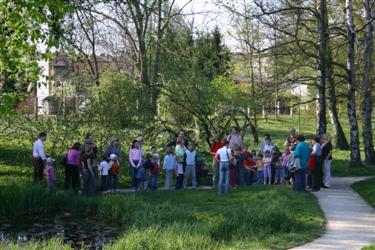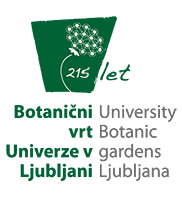
The Botanic Garden is a piece of real nature in the very center of Ljubljana and within easy reach of its inhabitants. A wide range of topics may make you wish to return to the Garden several times in the course of the same month or in different seasons, yet the topic will never be the same as on your previous visit.
Children love our workshops because they take part in all activities and so never get bored. Children take their workshop products back home.
The knowledge of the world of plants is sadly in decline not only in our country but also in the world at large. Our expertly trained collaborators make children aware of the nature in which we live but hardly notice at all. We suggest you take a look at our program of topics and schedule of charges, see how you register for a guided tour and then visit us right away!
| Tree in the Four Season |
-
In the early spring time the lovely spring flowers we know so well - snowdrops, primroses, hellebores, crocuses, winter aconites - are blooming in the Botanic Garden . A colourful carpet below the still leafless trees. At the workshop children plant spring flowers, create picture with hearlds of spring or (pupils only) make models of heralds of spring.
Performed in early spring when these plants bloom in the garden. -
Late spring in the Garden and in the puddle
The trees have already developed its foliage. Beneath them we encounter with its charactestic odour. More and more plants are in bloom. Life is awakening in the puddle to. We will observe animals in the puddle and children will try to catch animals with nets from our pools. At the workshop children fold frogs from paper and try them out in frog race orcreate a puddle collage.
Performed in May and June. -
Blooming Summer (pre-school only)
In the summer, meadows are in full bloom, bushes and flower beds are full of colorful flowers. We will draw a picture of the loveliest among them. most beautiful and learn about them. Above the colorful flowers, the buterflies, bees, bumble bees and other polinators are flying, between the vegetation and in the soil, many organisns are hiding. Which plants polinatos love and why are they visiting those flowers? Can you describe a life of a bumble bee? Do you know how a butterfly evolvels from caterpillar or what colors the bees can see?
Performed from June to September. -
Meadow (pupils only)
In summer, the meadow is full of colorful flowers. We wil draw a picture of the most beautiful and learn about them. Without the colorful flowers are grasses that are pollinated by wind and were a source of nowday grains for pre-historical people. Have you ever seen how corn grows? What about wheat? Above the colorful flowers, the insects are flying, between the vegetation and in the soil, many organisms are hiding.
Performed from May to September. -
Pumpkin the Pumpkin and Halloween
In the late Autumn timme we take a look at different kinds of pumpkins, learn how to say pumpkin in various parts of the world, dicscuss about Celtic New Year and Halloween and make a ghost, bat, spider, witch or pumpkin. If you visite us together with the parents, you can also carve jack-o'-lanterns or decorate lanterns made out of jars.
Performed in October. -
The leaves have assumed warm autumnal colours and are already beginning to fall away. Why leaves change colour in autumn and fall of? We collect different leaves and try to draw them. We try to find out which leaves and fruits belong to the same tree. Among the maturing fruits there are some that we already know: walnuts and chesnuts, beech nuts, acorns, and maple tree "helicopters". At the workshop we read a story and children make autumn hats.
Performed from September to November. -
Botanic Garden is interesting even in the winter. Residues of dried plants, covered with snow or frost are real garden ornaments. In January witch-hazel starts to bloom, otherwise conifers are more prominent during winter. At the workshop children create New Year Card or book pointer from dried leaves and flowers or little man from cone for Christmas tree.
Performed in winter months. -
Who will be the first to find a snail shell? Whose cone is the biggest of all? How many of us must hold hands to form a circle around the linden tree which is the oldest tree in the garden? Do we know how it feels to caress a tender newt? What does the goldfish feed on? Do snails also live in water? What colour is the waterlily? Let us take a look at a tulip flower! How does a peanut grow? Are blooms the only part of plants that have an odour? In different seasons, weather conditions and parts of the day, the experiences differ greatly!
Performed throught the year. -
Who would not want to observe the development of a plant from seed on? When we open delicious orange, sour lemon, big grapefruit and found the seeds in them, we plant them and carefully. We discuss the reason why the bottom of the flower pot has a hole in it, why a shard should be placed over the hole, why plants need water, how a new plant will develop from the seed. Instead of planting seeds into ordinary pots, we can make a real sprouters so that every day we can take a look if our seed has sprouted yet. We also learn about special plants that do not need seeds for propagation and what are the cuttings. Instead of seeds, you can select a young plant with roots and transplate it into your pot and take it home with you. You can combinate this workshop with the themes Hearlds of Spring, Blooming Summer, Meadow, Traveling to the Tropics or Looking for Adventure.
Performed throught the year. -
Fruits and dispersal of Plants
The plants of our region and of foreign countries terminate the growth period through the autumn growthing season through the maturing of their fruits. Some fruits are widely known while others attract attention for their unusual shape. Some are edible while others may be worked into animal shapes. Some are encased in a rock-hard shell, others are juicy and odorous. How many different fruits will we count? At the workshop children create models of maple tree fruits and test which of them fly best or create with fruits.
Performed from September to November. -
Tropical glasshouse is pleasantly warm, the plants abundantly grow and remind us of the summer. Have you ever been in South America, Asia, Australia or Africa? No? Then came and take a trip with us! We eill meet tasty vannilla, hide under leaves of banana tree, see plants from the time of dinosaurs... Beside tropical plants that we often have in our homes or take part in our diet, We will also take a look at carnivorous plants. Do you want to know what they eat, how theey hunt their pray and why or how many different we can find? At the workshop children plant or make model of carnivorous pant.
The Tropical glasshouse is attractive all year round, so you can visit it anytime. -
How many trees do we recognize when taking a walk through a forest? Do we distinguish spruce from fir and yew? We will learn about some of our best known trees, collect their leaves and paste them beside the bark imprints that here will make together. At the workshop children plant a tree, create a model of a tree from cardboard or in autum when leaves take on vivid colours and drop from trees, make imprints of leaves.
Performed from April to November. -
Trees in superlatives (pupils only)
How thick is Najevnik linden tree? Which trees grow in the time of dinosaurs? Can you describe the bark of world highest trees? Which conifers loose leaves in autumn? Which tree blooms from the tree trunk? Wood of which tree burns even wet? At the workshop children are trained in close observation, learn about different cones, determine the age of the tree and look for different parts of the same tree.
Performed from April to November. -
Which seasons we know? Are four seasons present worldwide? Do you kow that they have winter in Australia, when we have summer? What causes the season? Are trees the same through all seasons? We will find answers to all these questions and give trees on flexagone the covering in spirit of the season. You can combinate this workshop with themes Late spring in the Garden and in the Puddle, Looking for Adventure, Autumn in the Forest, Winter in the Botanic Garden, Trees of our Forest, Trees in superlatives and/or with planting.
Against additional payment, all themes and workshops can be performed in combination with planting.







